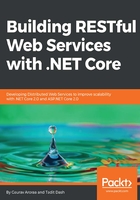
Resource-oriented architecture
Every resource on the web has been given a unique identifier, otherwise known as a URI. The uniform resource locator (URL) is the most common type of URI used on the web today. The URL https://www.packtpub.com/ identifies and locates the Packt Publishing site.
Let's look at a quick picture of the architecture. In the following diagram, a client is trying to access a resource through an identifier (URL). The resource is present on the server and has a representation that can be returned to the client when requested:

As the name suggests, the URL is something that is tied to only one resource; therefore, if I want to point someone to one resource, I can easily share that identifier in email, chat, and so on.
These identifiers can by easily remembered if they are named with company or resource names. The best example is www.google.com, which is very easy to remember as the name Google is present. Therefore, we can spread the resource link by word of mouth and you can enter it into a web browser, such as Chrome or Firefox, within seconds.
You might find hyperlinks on a particular web page that link to another website for another resource. That means that resources are now interconnected because of the hyperlinks.
These interconnected resources form the resource-oriented architecture. Hyperlinks make it easy to navigate from one resource to another by using the target resource URI.
For example, in HTML, you link to another resource through the anchor element. The following is one anchor element that links to Packt's IoT book catalog page:
<a href="https://www.packtpub.com/tech/Internet%20of%20
Things">Packt IoT Books</a>
By default, the anchor element is rendered as an underlined text. When you hover over it, you can see the attached URI at the bottom, as shown in the following screenshot:

You can click on the anchor text (Packt IoT Books), which then fires a GET request for the target resource URI.
Note that the moment you click the hyperlink, you will land on a web page that is actually a representation of a resource. The most common representation you will encounter is in HTML format. Some other common formats are (X)HTML, JPEG, GIF, WMV, SWF, RSS, ATOM, CSS, JavaScript/JSON, and so on. When a browser receives one of these representations, it tries to parse it and then renders it for viewing, if parsing succeeds.